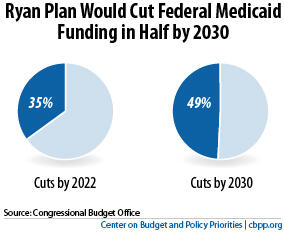BEYOND THE NUMBERS
Converting Medicaid to a block grant and cutting its federal funding nearly in half over the next two decades, as House Budget Committee Chairman Paul Ryan’s budget would do (see graph), would carry serious consequences for some of the most vulnerable Americans, as I explain in a recent report. Here are just a few examples of how different groups could be affected:
- Seniors: An overwhelming majority of Medicare beneficiaries who live in nursing homes rely on Medicaid for their nursing home coverage. Because the Ryan plan would require such deep cuts in federal Medicaid funding, it would inevitably result in less coverage for nursing home residents and shift more of the cost of nursing home care to elderly beneficiaries and their families. A sharp reduction in the quality of nursing home care would be virtually inevitable, due to the large reduction that would occur in the resources made available to pay for such care.Image

- People with disabilities: These individuals constitute 15 percent of Medicaid beneficiaries but account for 42 percent of all Medicaid expenditures, mostly because of their extensive health and long-term care needs. Capping federal Medicaid funding would place significant financial pressure on states to scale back eligibility and coverage for this high-cost population, many of whom would be unable to obtain coverage elsewhere because of their medical conditions.
- Children: Currently, state Medicaid programs must provide children with health care services and treatments they need for their healthy development through the Early Periodic Screening, Diagnostic and Treatment (EPSDT) aspect of Medicaid, which provides regular preventive care for children and all follow-up diagnostic and treatment services that children are found to need. A block grant would likely permit states to drop EPSDT coverage, meaning that children, particularly those with special health care needs, would not be able to access some care that medical professionals find they need (because Medicaid would no longer cover certain health services and treatments for children, and their parents wouldn’t be able to afford to pay for that care on their own).
- Working parents and pregnant women: Many state Medicaid programs already have extremely restrictive eligibility criteria for parents. In the typical state, working parents are ineligible for Medicaid if their income exceeds 64 percent of the poverty line (or $14,304 a year for a family of four), and unemployed parents are ineligible if their income exceeds 37 percent of the poverty line ($8,270 a year for a family of four). Under a block grant, states could cut these already low eligibility levels even further, cap enrollment, and/or require low-income parents to pay more for health services. States could do the same for low-income pregnant women who rely on Medicaid for their prenatal care, resulting in them forgoing services that are critical to ensuring a healthy pregnancy.
Unfortunately, that’s not all. The Ryan budget, which the House passed on April 15, would also repeal the health reform law’s Medicaid expansion. Health reform will result in some 17 million more people gaining coverage through Medicaid by 2021, according to the Congressional Budget Office. If it’s repealed, millions of low-income parents and childless adults would remain uninsured.
